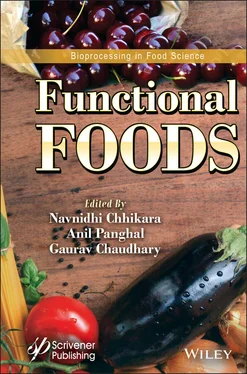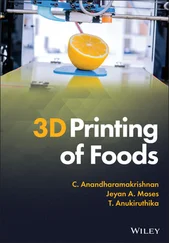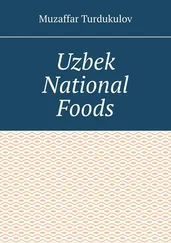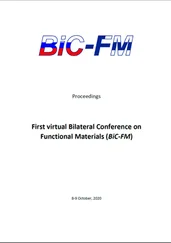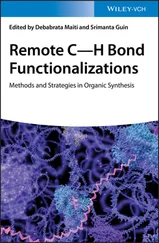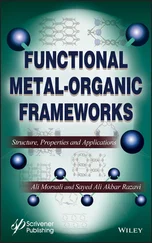Functional Foods
Здесь есть возможность читать онлайн «Functional Foods» — ознакомительный отрывок электронной книги совершенно бесплатно, а после прочтения отрывка купить полную версию. В некоторых случаях можно слушать аудио, скачать через торрент в формате fb2 и присутствует краткое содержание. Жанр: unrecognised, на английском языке. Описание произведения, (предисловие) а так же отзывы посетителей доступны на портале библиотеки ЛибКат.
- Название:Functional Foods
- Автор:
- Жанр:
- Год:неизвестен
- ISBN:нет данных
- Рейтинг книги:3 / 5. Голосов: 1
-
Избранное:Добавить в избранное
- Отзывы:
-
Ваша оценка:
- 60
- 1
- 2
- 3
- 4
- 5
Functional Foods: краткое содержание, описание и аннотация
Предлагаем к чтению аннотацию, описание, краткое содержание или предисловие (зависит от того, что написал сам автор книги «Functional Foods»). Если вы не нашли необходимую информацию о книге — напишите в комментариях, мы постараемся отыскать её.
Presenting cutting-edge information on new and emerging food engineering processes,
, the second volume in the groundbreaking new series, “Bioprocessing in Food Science,” is an essential reference on the modeling, quality, safety, and technologies associated with food processing operations today.
This outstanding new volume:
Audience: Functional Foods
Functional Foods — читать онлайн ознакомительный отрывок
Ниже представлен текст книги, разбитый по страницам. Система сохранения места последней прочитанной страницы, позволяет с удобством читать онлайн бесплатно книгу «Functional Foods», без необходимости каждый раз заново искать на чём Вы остановились. Поставьте закладку, и сможете в любой момент перейти на страницу, на которой закончили чтение.
Интервал:
Закладка:
Studies report that flaxseed has a unique potential in preventing diseases including cardiovascular diseases, rheumatoid arthritis, osteoporosis, constipation, and various cancers (colon, breast, prostate cancers) and that it has positive effects on the immune system. Although the seeds of flax plants contain cyanogenic glycosides, linatine, and phytic acid, which negatively affect nutritional absorption, researchers have shown that no apparent negative results are experienced from the daily intake of 50 g of flaxseed [160].
3.2.6 Psyllium
Psyllium is present in seeds of plants of the genus Plantago , a genus that contains about 200 species growing widely within the world’s moderate climatic regions [175, 176]. It is a crop that has historically been utilized by people for millennia. For example, it was reported to have been used by the Chinese in 250 BC for both the plant itself and for the psyllium of the seeds. Although Plantago plants are harvested around the world, only the species Plantago ovata Forsk and Plantago psyllium are being commercially produced as main seasonal crops in various American, European, and South Asian countries as a result of their seed mucilage, pharmaceutical, cosmetic, and food-grade qualities [177]. From past to present, psyllium has traditionally been harvested for use as a fiber supplement for dietary support, as well as a laxative agent [175, 178]. Currently, psyllium has been utilized in the landscape industry and in domestic and industrial wastewater treatment [176, 178–180]. Psyllium husk is used in the pharmaceutical industry as a medically bioactive polysaccharide; it is also utilized for treating various diseases, as will be described below in detail [180, 181]. Furthermore, it has valuable roles within the food industry, specifically in the creation of gels and for increasing consistency and stability [180, 182]. The species called Plantago ovata Forsk is widely grown in Iran and India [176, 180]. India leads the global market in both producing and exporting this product. Approximately 39,000 tons of psyllium seeds are produced each year in India, and 85% of psyllium seeds are supplied to the world market annually by India [176, 183, 184]. Blond psyllium, ispa-ghula, Indian plantago, and spagel are various common names for Plantago ovata Forsk [176, 180]. Psyllium plants grow to 15 cm in length. They are covered with fuzzy hairs, white in color, which grow at right angles to the leaves and stems. Seeds have small dimensions (1.5–2 cm) with brown or reddish brown coloring, and they possess large amounts of albuminous substances and mucilage. Seeds undergo drying and crushing, a process by which psyllium husk is obtained [177]. The latter constitutes the major product of psyllium seed. Remaining seed materials are often used in food products for animals [176, 183, 184].
The various possible applications of psyllium in pharmaceutical fields and in functional food production can be explained as being due to the unique chemical properties of psyllium husk. Psyllium husk has 6.83% moisture, 4.07% total ash, 2.62% soluble ash, 0.94% protein, and 84.98% total carbohydrate on a dry basis. As seen, the main components of psyllium husk are polysaccharides [178]. Psyllium husk can be considered as a neutral arabinoxylan containing 21.96% arabinose, 56.72% xylose on a molar basis, and some other sugar residues [178, 185, 186]. The monosaccharide composition of psyllium husk consists of rhamnose (1.5%), galactose (3.76%), glucose (0.64%), and mannose (0.40%) other than arabinose and xylose. Psyllium husk contains the lowest amount of phosphorus (140 μg/g) and magnesium (150 μg/g) while the major mineral substances of psyllium husk are potassium (8500 μg/g) and calcium (1500 μg/g) [178].
The psyllium polysaccharides mentioned above have been associated with the treatment of many diseases such as constipation [181, 187, 188], diarrhea [181, 189], inflammatory bowel diseases and ulcerative colitis [181, 190], childhood and adolescent obesity [181, 191], high levels of cholesterol [48, 181, 184, 192–196], colon cancer [181], and diabetes [181, 194, 197–200].
3.2.7 Brown Rice
Oryza sativa L., or rice, is the cereal grain cultivated most heavily on a global level [201–203], being grown in more than 100 countries [204, 205]. In rice cultivation, the ability to use soils that have different temperatures, various levels of moisture from dry conditions to marshiness, and many different textures, such as muddy or sandy, ensures that rice remains a producible cereal worldwide [206, 207]. Over 90% of all rice globally produced is grown and processed in Asia. Rice is a livelihood for 2.5 billion people [205, 208], and it constitutes the main source of sustenance for almost 50% of the global population [202, 203]. It is primarily produced for consumption by humans, which is the destiny of over 80% of all produced rice, and it is less commonly used as an animal feed [207, 209].
The production of brown rice occurs with the dehulling of rough rice. It comprises layers of 6%–7% bran layers and 2%–3% embryo, with a large majority of approximately 90% being constituted by the endosperm [202, 210]. White rice is also known as polished rice, procured by the removal of bran from brown rice. Although slight variations exist according to the degree of milling, white rice is essentially understood to be composed of only endosperm [207, 209].
The composition of brown rice has been reported by Zhou and Zhang (2002) [211] as protein (7.1–13.1 μg/g), crude fat (1.8–4.0 μg/g), crude fiber (0.2–2.6 μg/g), vitamin A (0.1 μg/g), vitamin B 1(2.1–4.5 μg/g), vitamin B 2(0.4–0.9 μg/g), vitamin B (0.005 μg/g), vitamin E (13 μg/g), nicotinic acid (44–62 μg/g), pyridoxol (1.6–11.2 μg/g), pantothenic acid (6.6–18.6 μg/g), biotin (0.06–0.13 μg/g), total inositol (1194–1220 μg/g), free inositol (24–45 μg/g), choline (1120–1220 μg/g), and folic acid (0.20–0.60 μg/g). The mineral substances of brown rice are 65–400 μg/g Ca, 203–275 μg/g Cl, 7–54 μg/g Fe, 13–42 μg/g Mn, 2500–4400 μg/g P, 1200–3400 μg/g K, 31–176 μg/g Na, and 15–22 μg/g Zn [205]. Brown rice has higher ratios of fundamental nutrients than its white counterpart. Also, it contains extra bioactive compounds like γ-oryzanol, ferulic acid, and gammaaminobutyric acid that are primarily found in the germ and in the bran layers [205, 206, 212]. In spite of its considerable nutritional value, brown rice is less likely to be consumed than white rice is on account of its rougher texture, lower digestibility, an off-putting bran odor, and longer cooking times [205–207, 213]. To overcome these negative features, the consumption of germinated brown rice can stand out [207].
Brown rice is a favorite of both standard diets and special diets prepared for individuals afflicted by celiac disease and/or those who are intolerant to other grains. Besides its nutritional value, brown rice is one of the excellent functional foods because it reduces risks of various chronic diseases and has a positive impact on overall health [214]. Scientific research has confirmed the health-promoting activities of brown rice, such as alleviation of pain and anxiety, standardization of both blood pressure and heart rate, suppression of liver damage, improvement of autonomic disorders and sleeplessness related to presenile or menopausal periods, inhibition of cancer cell proliferation, reduction of diabetes risk, and protection against oxidative stress [214–217].
3.2.8 Other Cereals
Millet is the oldest summer cereal crop used in human civilizations, together with wheat and barley. Its growing season is quite brief, lasting only 10 or 11 weeks. It can be cultivated in a wide area range [218, 219]. The species of millet are the staple cereal sources in Africa. The only species of millet grown for food consumption on a larger scale in northern countries such as Canada, the United States, and Europe is Panicum mili-aceum L. subsp. miliaceum , commonly referred to as proso millet or common millet [220, 221].
Читать дальшеИнтервал:
Закладка:
Похожие книги на «Functional Foods»
Представляем Вашему вниманию похожие книги на «Functional Foods» списком для выбора. Мы отобрали схожую по названию и смыслу литературу в надежде предоставить читателям больше вариантов отыскать новые, интересные, ещё непрочитанные произведения.
Обсуждение, отзывы о книге «Functional Foods» и просто собственные мнения читателей. Оставьте ваши комментарии, напишите, что Вы думаете о произведении, его смысле или главных героях. Укажите что конкретно понравилось, а что нет, и почему Вы так считаете.
